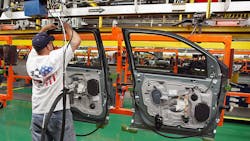Still Smiling: Another Quarter of Optimism for Manufacturers
For the nine consecutive quarters, manufacturers like what they see. In the first quarter of this year, 89.5% of respondents to NAM's Manufacturers' Outlook Survey are positive about their own company’s lookout.
“Manufacturing in the United States is on the rise, and manufacturers are confident about the future,” said NAM CEO Jay Timmons.
“Empowered by tax reform and regulatory certainty, manufacturers are investing in our communities and in our people," Timmons added in a statement. "But to keep up this momentum, we have to get serious about infrastructure investment and attracting, recruiting and training our people for the high-tech, high-paying modern manufacturing jobs of today and tomorrow.”
There are however still concerns with the top two being infrastructure concerns and the workforce shortage. With regard to infrastructure, more than 77% of survey respondents say it's not up to standards and threatens their competitiveness.
The group pointed out that its blueprint, "Building to Win" offers a plan to “ help secure American prosperity, job creation and our leadership in the world.”
Key recommendations from “Building to Win” include the following:
-- Implement strong accountability measures to ensure funds go to projects offering the greatest value for businesses, families and the economy.
-- Relieve highway bottlenecks and repair America’s crumbling highways and bridges.
--Create a reliable, user-based, long-term funding stream so users can have the safe, efficient highways needed.
-- Accelerate the implementation of NextGen air traffic management technology and upgrade our runways and airports to world-class standards.
-- Take an expedited approach to deepen ports, upgrade aging locks and enhance intermodal connections by spending the balance in the Harbor Maintenance Trust Fund.
-- Eliminate the maintenance backlog for public transit, commuter rail and passenger rail.
-- Promote regulatory and fiscal policies that incentivize continued record levels of private capital reinvestment in our railroads.
--Create an independent, bipartisan transportation commission.
--Streamline regulations to reduce the cost of delayed infrastructure.
--Promote new energy infrastructure investments as a means of improving U.S. infrastructure’s resilience to climate change.
--Robustly expand public-private partnerships for drinking water and wastewater projects.
--Streamline regulatory processes across multiple agencies and levels of government to foster the use of next-generation communications infrastructure, such as cutting-edge broadband or 5G technologies.
With regard to the lack of workers, the survey found that the inability to attract and retain a quality workforce remained manufacturers’ top business concern (71.3%). And the effects of this have been felt as it has forced more than one in four manufacturers surveyed to turn down new business opportunities.
About the Author
IW Staff
Find contact information for the IndustryWeek staff: Contact IndustryWeek
